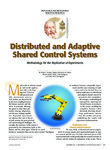Distributed and Adaptive Shared Control Systems: Methodology for the Replication of Experiments
| dc.contributor.author | Stoelen, MF | |
| dc.contributor.author | de Tejada, VF | |
| dc.contributor.author | Huete, AJ | |
| dc.contributor.author | Balaguer, C | |
| dc.contributor.author | Bonsignorio, FP | |
| dc.date.accessioned | 2016-04-28T10:26:39Z | |
| dc.date.available | 2016-04-28T10:26:39Z | |
| dc.date.issued | 2015-12 | |
| dc.identifier.issn | 1070-9932 | |
| dc.identifier.issn | 1558-223X | |
| dc.identifier.other | 4 | |
| dc.identifier.uri | http://hdl.handle.net/10026.1/4550 | |
| dc.description.abstract |
Much work in robotics aimed at real-world applications falls in the large segment between teleoperated and fully autonomous systems. Such systems are characterized by the close coupling between the human operator and the robot, in principle, allowing the agents to share their particular sensing, adaptation, and decision-making capabilities. Replicable experiments can advance the state of the art of such systems but pose practical and epistemological challenges. For example, the trajectory of the system is governed by the adaptation both in the human and the robot agent. What do we need besides (or instead of) data sets for such a system? The degree of similarity between comparable experiments and the exact meaning of replication need to be clarified. Here, we explore replication of a distributed and adaptive shared control for an assistive robot manipulator. We attempt a methodological approach for reporting two virtual human experiments on the system: modeling the complete human-robot binomial, deriving closedloop performance metrics from the models, and openly publishing the results and experiment implementations. | |
| dc.format.extent | 137-146 | |
| dc.language.iso | en | |
| dc.publisher | Institute of Electrical and Electronics Engineers (IEEE) | |
| dc.title | Distributed and Adaptive Shared Control Systems: Methodology for the Replication of Experiments | |
| dc.type | journal-article | |
| dc.type | Journal Article | |
| plymouth.author-url | https://www.webofscience.com/api/gateway?GWVersion=2&SrcApp=PARTNER_APP&SrcAuth=LinksAMR&KeyUT=WOS:000366416800015&DestLinkType=FullRecord&DestApp=ALL_WOS&UsrCustomerID=11bb513d99f797142bcfeffcc58ea008 | |
| plymouth.issue | 4 | |
| plymouth.volume | 22 | |
| plymouth.publication-status | Published | |
| plymouth.journal | IEEE Robotics & Automation Magazine | |
| dc.identifier.doi | 10.1109/mra.2015.2460911 | |
| plymouth.organisational-group | /Plymouth | |
| plymouth.organisational-group | /Plymouth/Faculty of Science and Engineering | |
| plymouth.organisational-group | /Plymouth/REF 2021 Researchers by UoA | |
| plymouth.organisational-group | /Plymouth/REF 2021 Researchers by UoA/UoA11 Computer Science and Informatics | |
| dcterms.dateAccepted | 2015-01-01 | |
| dc.rights.embargodate | 2023-6-23 | |
| dc.identifier.eissn | 1558-223X | |
| dc.rights.embargoperiod | No embargo | |
| rioxxterms.versionofrecord | 10.1109/mra.2015.2460911 | |
| rioxxterms.licenseref.uri | http://www.rioxx.net/licenses/all-rights-reserved | |
| rioxxterms.type | Journal Article/Review |


